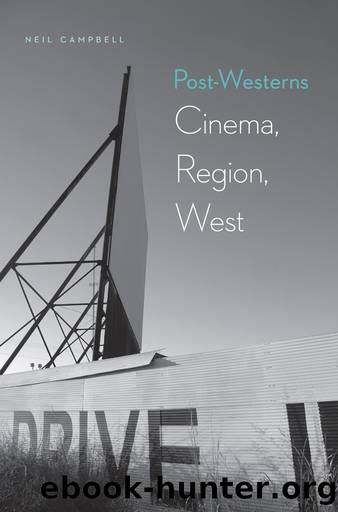Post-Westerns by Neil Campbell

Author:Neil Campbell [Campbell, Neil]
Language: eng
Format: epub
ISBN: 978-1-4962-0962-7
Publisher: University of Nebraska Press
Published: 2013-07-14T16:00:00+00:00
The “Strange Phosphorous of Life”
For Sayles, reconciliation signifies this potentiality between the past, present, and future, as in other compacts between antagonistic characters: between Otis and Delmore, when the latter sees the “shrine” to him at Big O’s home; between Mercedes and her past, when she helps Enrique’s fiancé to safety in the United States; and between Chet and Delmore, when the latter softens to both his son and his father, accepting that the “army isn’t for everyone” and they might have a barbecue to reconcile the family. The central reconciliation is, of course, between Sam and Buddy as Sam tells Hollis his version of events, concluding with his claim that “Buddy Deeds was a murderer,” before he hears the truth from Otis. The creation of the legend is explained, and as Otis says, “As time went on, people liked the story we told better than anything the truth might have been.” It is now up to Sam to interrupt that time, to make a choice as to whether or not Wade’s murder by Hollis should be revealed. Ultimately, following the tradition of The Man Who Shot Liberty Valance, he opts for silence, to bury the truth and allow the legend to remain. “It’s just one of your unsolved mysteries,” he says. As discussed earlier, for Fregoso this fails to “decenter whiteness and masculinity” and so leaves her feeling shortchanged on the film’s commitment to “critical border theory” and to a “politics of transformation, to affecting social change and to a vision of a more egalitarian social order.” For Fregoso, the film fails “to rewrite the script of the nation,” settling instead for resituating white masculinity in the place of power, crossing racial and sexual boundaries while maintaining racial and masculine privilege.59
Another way of seeing the film’s conclusion is that the knowledge of the past and the delving into communal and personal memory has brought Sam and others (Mexicans, women, African Americans, Native Americans) to moments of intense reconciliation not as an act of closure or some final statement on the border or the nation but as the possibility of beginning or “becoming,” as Deleuze would term it, creating new relationships out of this coalescence of past and present. As a filmmaker, according to George B. Handley, Sayles has acted radically, since “even though history may have prescribed ‘America’ as a fated, sealed identity, we can humanize and open that identity, give it dimension and dynamism, by projecting our imagination into other American lives across racial and national boundaries.”60 In opening identity, I would add, Sayles points toward a people to come, an alternate American West “to supplement ‘a national consciousness which is often inert and always in process of disintegration’” through a recognition of increasingly interlinked, interdependent communities.61
Sam and Pilar’s reconciled love at the finale provides a productive revision of the oldest taboo of miscegenation across races and suggests an allegorical hybrid American identity, a mixing of bloods, not in war, violence, and disagreement but in hope and renewed possibility as an ironic, revisionist Edenic couple heading a symbolic new family.
Download
This site does not store any files on its server. We only index and link to content provided by other sites. Please contact the content providers to delete copyright contents if any and email us, we'll remove relevant links or contents immediately.
The Kite Runner by Khaled Hosseini(4437)
Gerald's Game by Stephen King(3918)
The Perils of Being Moderately Famous by Soha Ali Khan(3783)
Dialogue by Robert McKee(3582)
Story: Substance, Structure, Style and the Principles of Screenwriting by Robert McKee(2986)
The 101 Dalmatians by Dodie Smith(2937)
The Pixar Touch by David A. Price(2740)
Confessions of a Video Vixen by Karrine Steffans(2675)
Fantastic Beasts: The Crimes of Grindelwald by J. K. Rowling(2543)
How Music Works by David Byrne(2526)
Slugfest by Reed Tucker(2417)
Harry Potter 4 - Harry Potter and The Goblet of Fire by J.K.Rowling(2416)
The Mental Game of Writing: How to Overcome Obstacles, Stay Creative and Productive, and Free Your Mind for Success by James Scott Bell(2393)
Wildflower by Drew Barrymore(2118)
Scandals of Classic Hollywood: Sex, Deviance, and Drama from the Golden Age of American Cinema by Anne Helen Petersen(2109)
Casting Might-Have-Beens: A Film by Film Directory of Actors Considered for Roles Given to Others by Mell Eila(2072)
Screenplay: The Foundations of Screenwriting by Syd Field(2057)
Robin by Dave Itzkoff(2005)
The Complete H. P. Lovecraft Reader by H.P. Lovecraft(1977)
